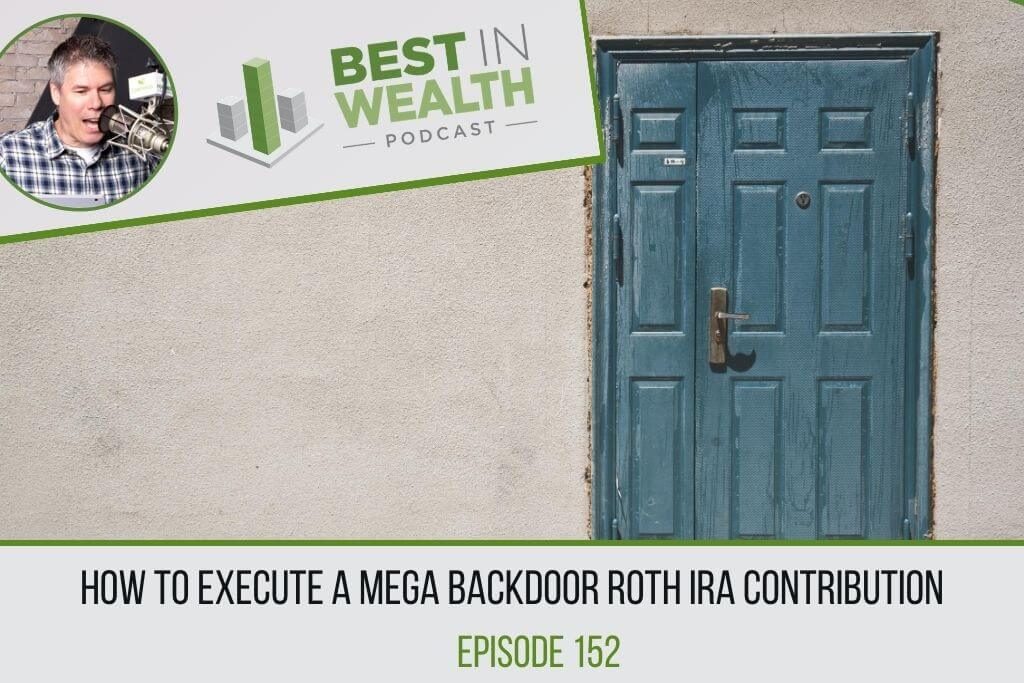How to Execute a Mega Backdoor Roth IRA Contribution, Ep #152

What is the Mega Backdoor Roth IRA Contribution? How can it be a game-changer for some high-earning individuals who are already maxing out their 401k plans? If you are investing the maximum you can a year, think of how quickly you can hit financial freedom. If you are passionate about investing as much of your income as you can, this is the episode for you. I explain the step-by-step process of finding out if you qualify. Don’t miss it!
How do you execute a Mega Backdoor Roth IRA contribution? Find out in this episode of Best in Wealth! #wealth #retirement #investing #invest #PersonalFinance #FinancialPlanning #RetirementPlanning #WealthManagement Click To TweetOutline of This Episode
- [1:33] Dissecting the total compensation package
- [4:34] Executing a Mega Backdoor Roth IRA Contribution
- [6:55] Does your 401k plan allow non-Roth after-tax contributions?
- [9:46] Is there room under the ACP test to make additional contributions?
- [11:39] Calculating how much you can contribute
- [13:23] Does your plan allow for in-service distributions?
- [16:44] Are the non-Roth after-tax contributions moved to a separate account?
Mega Backdoor Roth 101
The first question you have to ask: Have I made the maximum salary deferral contribution of $19,500 into my 401k? If you are 50 or older, have you contributed $26,000? If you have not maxed it out, you do not qualify for the Mega Backdoor. You have to focus on maxing out your 401 contributions first.
Secondly, does your 401k plan allow non-Roth after-tax contributions? The answer can be found in your summary plan description (SPD). Your employer is legally required to give this to you when you are hired—and if you ask for it again. If you login to your 401k provider’s website, you will often find it under the “documents” tab. If you cannot find it, email your HR representative and ask for a copy.
If your plan does not allow the non-Roth after-tax contribution—you cannot move forward. If it IS allowed, you can contribute above and beyond $19,500 (or $26,000). You CAN continue along this journey. The truth is most plans do not allow this, but it is worth finding out.
Is there room under the ACP test to make additional contributions?
An ACP test is typically conducted each year to make sure the 401k plan does not unfairly benefit a highly-compensated employee. It limits the amount of contributions that highly compensated employees can make. If you have maxed out your 401k, you will likely fall into that category. Ask your plan sponsor if you are considered highly-compensated.
What happens if you do not ask? When the ACP test is done at the end of the year—after you have made the contributions—the money you contributed can get sent back. But if the plan sponsor says you are not considered highly compensated, you can move forward.
In this episode of Best in Wealth, find out how to calculate how much you can contribute to a Mega Backdoor Roth! #wealth #retirement #investing #invest #PersonalFinance #FinancialPlanning #RetirementPlanning #WealthManagement Click To TweetHow to calculate how much you can contribute
How do you calculate how much you can contribute? Add all of the employee and employer contributions that have been made this year. Note, if you are 50 or over, you do NOT count the extra $6,500 contribution. Once you have added up the total contributions, subtract it from $57,000. Why?
In 2020 you can make up to $57,000 worth of total retirement contributions inside of your plan. If you have more than one 401k, add up every plan you have contributed to. Take $57,000 and subtract $19,500 plus what your employer contributes (varies by employer). If for example, you arrive at $31,500, that is the amount you can contribute to the non-Roth after-tax portion of your IRA.
Does your plan allow for in-service distributions?
You can find the answer to this in your summary plan description (SPD) as well. Generally speaking, to withdraw money from a retirement plan, you must either retire or leave that employer (unless you are taking out a loan). But most plans allow an in-service distribution. So that while you are still working for the employer, you can withdraw money.
Many plans that allow the non-Roth after-tax contribution allow for in-service distributions of that money. If your plan does not allow in-service distributions, you can still make a Mega Backdoor Roth IRA contribution—but you will lose some of the tax benefits. If you leave your employer, you can roll the whole portion into a Roth IRA. But any earnings on that portion will be taxed as income when you roll it over.
If your 401k allows for a non-Roth after-tax contribution AND an in-service distribution, then you can move on to the final step.
Why do you want a financial advisor to help you navigate a Mega Backdoor Roth IRA contribution? I share my thoughts in this episode of Best in Wealth! #wealth #retirement #investing #invest #PersonalFinance #FinancialPlanning #RetirementPlanning… Click To TweetHave you moved the non-Roth after-tax contributions to a separate account?
If your 401k allows for a non-Roth after-tax contribution AND an in-service distribution—are the non-Roth after-tax contributions moved to a separate account? If the answer is yes, you CAN do the Mega Backdoor Roth IRA contribution. Once the contribution goes in, you can immediately take that after-tax portion and roll it into a Roth IRA while working for your employer. It will grow tax-free for the rest of your life. That is a Mega Backdoor Roth IRA!
How do you manage the Mega Backdoor Roth contribution? Do you need a financial advisor? If you are not paying attention, this could blow up in your face. How? I share my thoughts—and all the nitty-gritty details—in this episode.
Resources Mentioned
Connect With Scott Wellens
- Schedule a discovery call with Scott
- Send a message to Scott
- Visit Fortress Planning Group
- Connect with Scott on LinkedIn
- Follow Scott on Twitter
- Fortress Planning Group on Facebook
Audio Production and Show notes by
PODCAST FAST TRACK
https://www.podcastfasttrack.com
Podcast Disclaimer:
The Best In Wealth Podcast is hosted by Scott Wellens. Scott Wellens is the principal at Fortress Planning Group. Fortress Planning Group is a registered investment advisory firm regulated by the Securities Act of Wisconsin in accordance and compliance with securities laws and regulations. Fortress Planning Group does not render or offer to render personalized investment or tax advice through the Best In Wealth Podcast. The information provided is for informational purposes only and does not constitute financial, tax, investment or legal advice.



